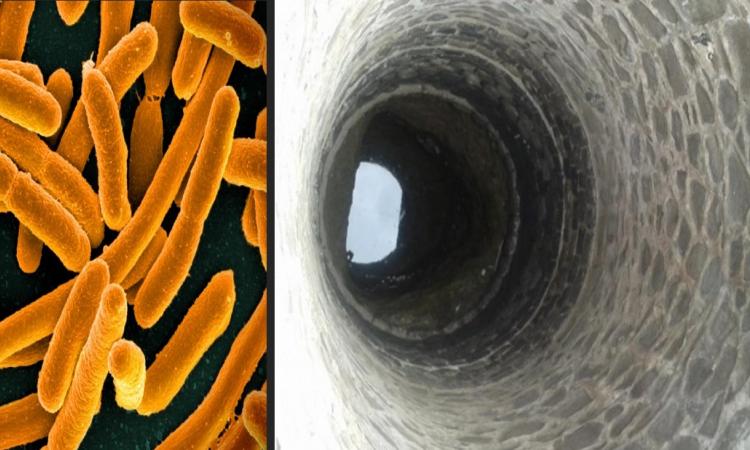
There is a huge dearth of cleanliness in India--open defecation is rampant; garbage management in most cities is in shambles; toxic hospital and industrial wastes and sewage are allowed to drain into water sources and food products are laced with chemicals.
However, we still seem to be oblivious to the much more dangerous consequence of this incessant poisoning of our water, soil and environment and its impact on health and survival. For lurking behind the filth are superbugs or antibiotic resistant bacteria causing antimicrobial resistance.
What is antimicrobial resistance and what are superbugs?
Microorganisms such as bacteria have a remarkable capacity to adapt and survive in adverse environments. Antibiotic resistance arises when such bacteria evolve mechanisms to withstand or resist the effects of antibiotics targeted to destroy them and fight infection by changing themselves. They can do so by secreting enzymes that can inactivate the antibiotic, change the permeability of their cell membranes to prevent entry of the antibiotic etc. These microorganisms that develop resistance to multiple antibiotics are also referred to as ‘superbugs’.”
When superbugs develop resistance to a particular antibiotic used to treat infections like say diarrhoea, the antibiotics can become ineffective. This will result in the person continuing to suffer from the condition which could even become fatal, increasing the risk of spread to others.
Antimicrobial resistance in India
Antimicrobial resistance is on the rise around the globe and indiscriminate usage of antibiotics to treat diseases coupled with insufficient wastewater treatment are to blame. However, there are very few studies that have looked at antimicrobial resistance in India, which is one of the largest manufacturers, consumers and polluters of antibiotics in the world.
Read more on antimicrobial resistance in India here
Patna, Bihar, is especially important as it is a rapidly developing city with inadequate wastewater infrastructure, situated along the mighty river Ganga, currently known to be contaminated by a range of organic contaminants informs this study titled 'Discovery of sulfonamide resistance genes in deep groundwater below Patna, India' published in Environmental Pollution.
Dependence on groundwater for drinking in the region is high. It is thus important to understand mechanisms that trigger surface-derived ingress and associated controls on the development of antimicrobial resistance in groundwater sources used for drinking in the state.
Among all the antibiotic groups found in water, sulfonamides are one of the oldest and least degradable. They are used and are highly effective against both gram-positive and gram-negative bacteria, along with some fungi and protozoa and are used to treat both human and animal bacterial infections.
This study aimed at quantifying and explaining the prevalence of three sulfonamide resistance genes (sulI, sulII and sulIII) in groundwater and surface water around the rapidly developing city of Patna, to build a new understanding of the development of sulfonamide resistance genes in Indian groundwater.
What did the study find?
- Three sulfonamide resistance genes namely (sulI, sulII, sulIII) were found in the groundwater (12-107 m depth) and surface water in Patna.
- The presence of the antibiotic resistant gene in groundwater in Patna (53–100 percent) was more frequent than in 20–40 m depth groundwater in Gujarat, which was at 10 percent.
- All the three sul genes in the study were detected in deep groundwater (sulI–III up to 91 m and sulI–II up to 107 m), which is increasingly targeted for drinking supplies in Bihar and other places in India.
- Groundwater sul abundance in this study was of similar magnitude to reported sul abundance in shallow groundwater near Shenzhen, China while the contamination was was one and two orders of magnitude lower in sulI and sulII genes/mL in the Ganga as compared to the Haihe river in China,
- The causes of antimicrobial resistance in groundwater and surface water in Patna were found to be related to contamination through urban drainage channels containing hospital and domestic wastes, or through shallow groundwater.
- The concentration of antimicrobial drugs in groundwater did not appear to directly correspond to the distribution of major hospitals in Patna nor the urban area, increasing the possibility that they were derived from veterinary-derived antibiotics and/or sewage ingress from less densely populated peri-urban or rural areas where wastewater infrastructure remains very limited.
- The presence of antimicrobial resistance genes could be more substantial in surface waters as compared to groundwater in the region with the concentrations being driven by numerous environmental factors.
The presence of antibiotic residues and resulting resistance in groundwater and major rivers in countries such as India is a cause for serious concern. Adequate waste management and remediation of antibiotic residues in water supplies is critical and requires policymakers, practitioners, scientists and other relevant stakeholders to come together and develop, implement and manage appropriate and effective interventions to mitigate risks to health. There is also an urgent need to monitor and conduct research on antibiotics and AMR gene distribution in aqueous water sources, particularly in groundwater used as drinking supplies in rapidly developing cities.
/articles/superbugs-find-their-way-bihars-groundwater